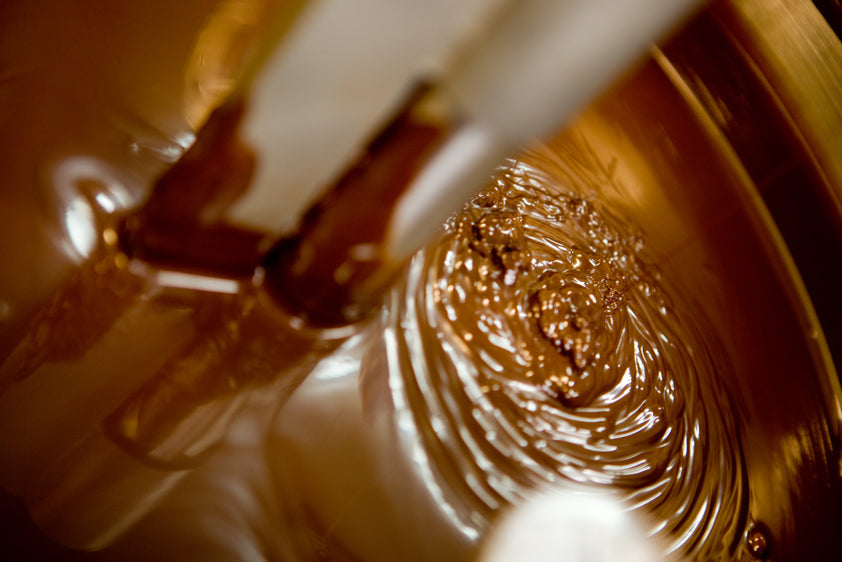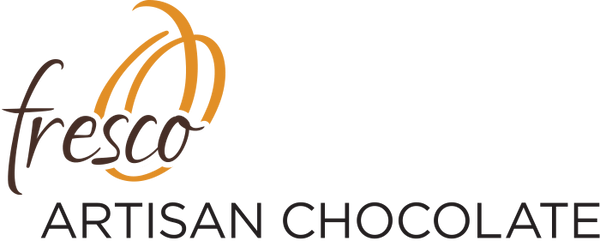
What is Chocolate Conching?
Share
The science, art, and slow mastery behind silky-smooth chocolate.
In the world of fine chocolate, conching is the transformative process that elevates gritty cocoa mass into the silky, aromatic indulgence we crave. For chocolate lovers and foodies alike, understanding conching offers a window into the meticulous craftsmanship behind each bar.
Where Conching Began
Conching was born from a happy accident in 1879. Swiss chocolatier Rodolphe Lindt left a mixer running overnight and returned to find the chocolate had transformed—gone was the coarse texture, replaced by a luxurious smoothness. The machine he used resembled a conch shell, giving this new step in chocolate making its name: conche.
Lindt’s discovery revolutionized the chocolate industry. No longer gritty and rough, chocolate could now be refined into a smooth, melt-in-the-mouth experience.
Rodolphe Lindt’s original conching machine - courtesy Lindt & Sprüngli
What Conching Really Does
Conching is far more than mixing. It’s a thermal, mechanical, and chemical transformation that unfolds over hours—or even days. At its core, conching uses motion, heat, and aeration to:
- Evaporate volatile acids like acetic, propionic, and butyric acids—compounds responsible for sharp, sour notes.
- Enhance flavor balance by oxidizing some components and softening harsh or bitter notes through gentle heat and extended aeration.
-
Refine texture by rounding off the edges of sugar and cocoa particles, creating a silky, seamless mouthfeel.
During conching, one unmistakable sign of progress is the vinegar-like aroma that can fill the room—evidence that acetic acid is being released from the chocolate. It’s sharp, a bit pungent, and entirely expected. This scent signals that the chocolate is shedding some of its more volatile components, making way for a more balanced and refined flavor profile.
The result? A chocolate that is smooth, aromatic, and deliciously complex.
Artisan Conching at Fresco Chocolate
At Fresco Chocolate, conching is both a science and an art—shaped by years of careful testing and deep respect for the uniqueness of each cocoa origin.
We begin with a stone mill called a melange, which uses heavy granite wheels to slowly grind cocoa nibs and cane sugar. This refining process can last several days, gradually reducing particle size to a smooth, melt-in-the-mouth texture.
But grinding isn’t just mechanical. As the stones shear against each other, they generate frictional heat—a byproduct that triggers an uncontrolled conche effect. Volatile acids begin to evaporate, and flavor starts to evolve, even before formal conching begins.
To manage this early flavor development, we often apply forced-air convection cooling during refining, helping regulate temperature and preserve desirable flavor characteristics.
Once the desired texture is achieved, we transition from refining to conching by reducing the stone pressure (to prevent over-refining) and gently heating the chocolate to accelerate evaporation of acidic compounds. This marks the beginning of a more controlled, intentional conching phase—one customized for each batch.
Tuning Flavor Through Conching
One of the most nuanced decisions a chocolate maker faces is how long—and how intensely—to conche a particular chocolate. But conche times aren’t one-size-fits-all. Every cocoa origin has its own personality, and the conche must be tailored accordingly.
That’s why we don’t refer to specific durations like “6 hours” or “48 hours.” Instead, we define our approach in relative terms—subtle, medium, or long conche—each reflecting how far we take the flavor development process for that particular batch.
- Subtle conche: Just enough to smooth the texture and reduce sharp acidity, while preserving vibrant, origin-specific flavor notes. For some origins, this may be as little as 30 minutes.
- Medium conche: A more balanced treatment that gently mutes acidity and rounds out the flavor, resulting in a harmonious and smooth chocolate.
- Long conche: Extended conching that significantly softens acidic notes and enhances mellow, caramelized, or roasted flavor qualities. Ideal for cacao with naturally robust profiles that benefit from deeper refinement.
Each chocolate is evaluated repeatedly during the conching process. We taste at regular intervals to determine when the flavor peaks—when the chocolate fully expresses the balance, aroma, and texture we’re after. For us, conching is not about hitting a target time, but about hitting the perfect moment for that specific cocoa origin.
That said, it is possible to over conche chocolate. When chocolate is conched for too long or at too high a temperature, the results can be disappointing. Delicate, origin-specific flavor compounds—developed during fermentation and roasting—can be stripped away by excessive aeration and heat. The final chocolate may be smooth, but flat and uninteresting in flavor. Precision matters.
The Final Word
Conching may not be as visually dramatic as tempering or molding, but it’s one of the most critical steps in artisan chocolate making. It’s where the flavors sharpen, soften, or bloom—where texture transforms and character is set.
For us, conching is a conversation between the chocolate and the maker. It’s a matter of listening closely, adjusting patiently, and knowing exactly when to stop.
